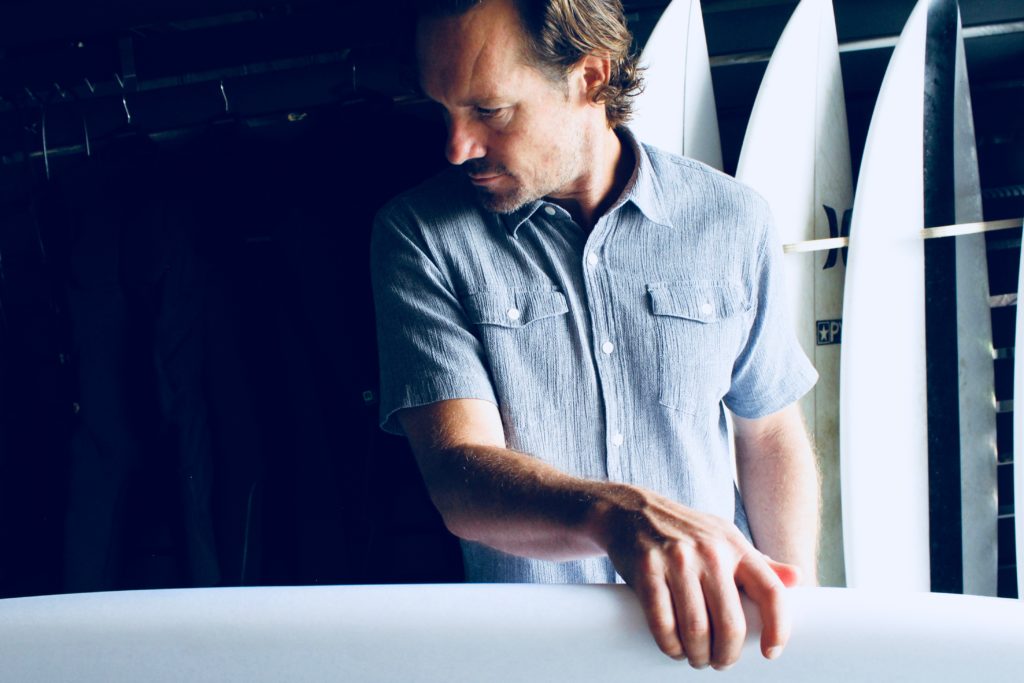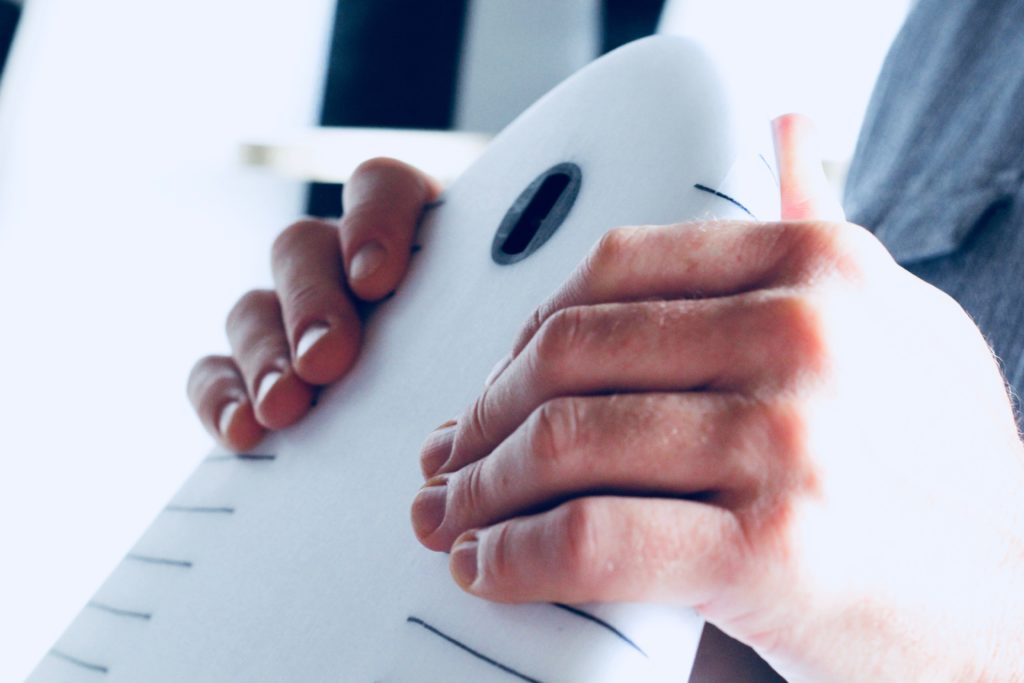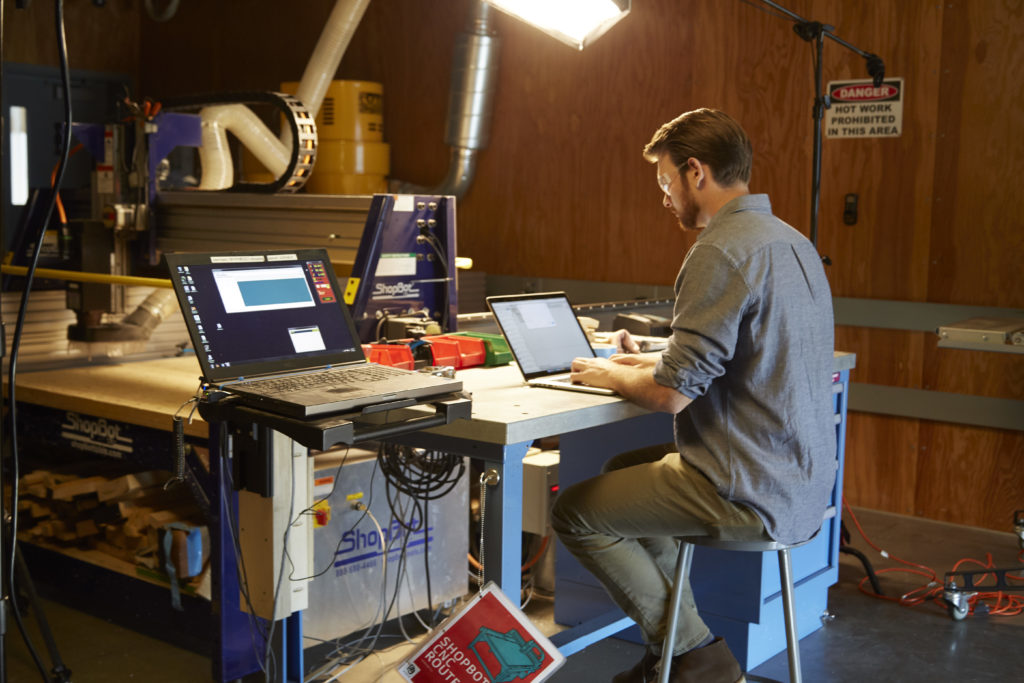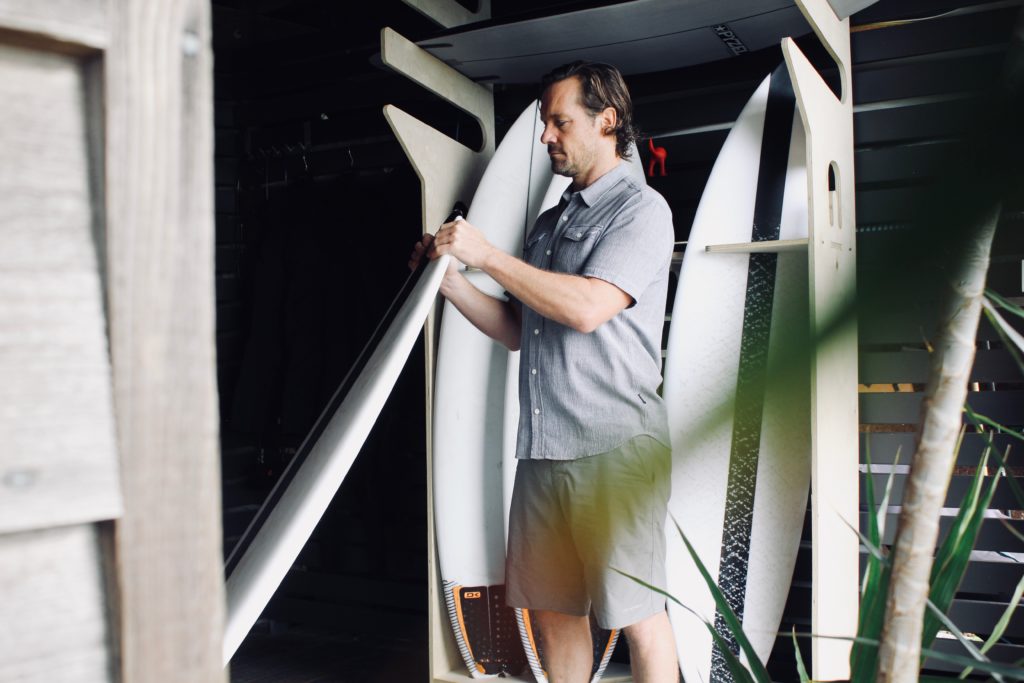By Mouncey Ferguson
When you think of surfing, chances are you picture an untrammeled, idyllic beach scene, with surfers coasting down waves just off the shore. For many surfers, the very act of surfing is associated with a connection to the ocean and nature itself.
It’s ironic, then, that the only object you need to surf—the surfboard—is a fragile thing made from petrochemical derivatives. For serious surfers, most boards last an average of six months to a year before they break or lose their spring. At that point, they end up either in the landfill or in the ocean itself, where they release toxic volatile organic compounds into the environment for years to come.
“The current industry standard is to use non-renewable resources like polyurethane or polystyrene foam coated with polyester or epoxy resins to make boards that are ultra-lightweight, but that have a very short lifespan,” says Stu Bowen, circular designer and founder of Lamina Flow, a surfboard technology company. “Then, when boards break, they basically become toxic waste. That’s the problem. It’s kind of the elephant in the room because surfing is perceived as part of this really fit and healthy, aspirational lifestyle.”
Roughly half a million surfboards are sold every year. “That means there’s potentially a million surfboards being discarded annually,” Bowen says. “That’s a big problem that’s not being talked about.”
The fact that surfers are simply accustomed to their boards snapping? That’s a different issue—another thing that few are looking at.
Bowen is solving both problems by taking a new approach to surfboard creation. Lamina is building boards that perform better, last longer, and in turn have less impact on the environment. He’s leveraging Autodesk tools to bring the latest digital design, simulation, and production tools into the process.
The surfboard, redux
The original surfboards used by Polynesians were made from natural materials like wood, since that was all that was readily available. That made surfboards durable and biodegradable—but also extremely heavy.
As surfing caught on globally through the 20th century, people started to use more modern manufacturing techniques to make surfboards lighter and more agile in the water. First, that meant hollow wooden boards. Then, in the 1930s and 1940s, board builders started using the same materials and approaches used to make modern boats—foams and fiberglass.
Today, most surfboards are made with a polyurethane or polystyrene foam core to provide buoyancy and a longitudinal and vertical wooden “stringer” that runs from nose to tail to provide stiffness. Then they wrap the whole thing in a fiberglass skin and coat it in resin.
The problem? When the flex of the wood exceeds what the foam and fiberglass skin can withstand, the whole board can snap. And every piece of wood is different.
The other problem? Every material used except for the stringer is derived from oil. That means they’re not renewable, and their journey moves in one direction: from excavation to fabrication to disposal. Bowen thinks there’s a better way.
Layers that flex
Drawing inspiration from skis and snowboards that are designed to bend, so they rarely break, Lamina’s approach is to engineer a core from a series of stacked layers (or laminas)—no stringer required. Without the unpredictability of the wooden stringer, the board’s stiffness and other physical characteristics can be precisely engineered.
Between the layers are various reinforcements that are pre-tensioned during curing, giving the board more of what scientists call “recoil longevity”—what surfers call “spring-back.” That refers to the ability of the materials to distribute stress uniformly—which means greater resistance to breakage.
In addition to boosting durability, Lamina is creating a board that can be replicated—not just in shape, but in riding dynamics. That means it can be produced efficiently at scale. Today’s surfboards start out as blanks which are then shaped by machine and hand-finished for specific riders and uses, which generates a lot of waste. Bowen points out that “every board is unique, first because every wooden stringer is unique, then because of the many variables during the complex and labor-intensive manufacturing process. Things like temperature, humidity, and human error play crucial roles during lamination and in the overall performance of the finished product. Professional surfers typically surf hundreds of boards each year, looking for the magic four or five they’ll use in competition. That’s a 20-to-1 ratio, which is totally impractical but still widely accepted in the industry. His engineered structure also delivers better performance. There are multiple forces working on a surfboard when it’s in the water—gravity, buoyancy, ocean energy, human weight, compression, and tension. A board’s ability to respond to all these forces well is commonly known as “liveliness” or “responsiveness” by those who ride. “Lamina boards are designed and engineered to provide flex, pop, and liveliness in spades,” Bowen says.
The business of conservation
Bowen has been working at the intersection of business and environmentalism his entire career, including time as a marketing manager and an environmental activist at Patagonia. In 2015, he co-founded Free the Reef to help rally support and protect Australia’s Great Barrier Reef. “I believe that business can be the solution to many of our environmental threats,” Bowen says. “We just have to work together to bring creative alternatives and solutions to market.”
A lifelong surfer, he began shaping in his teens. When he had the idea for the Lamina concept, he started creating prototypes by hand in his garage. He reached out to Taylor Stein, a technology evangelist at Autodesk, for advanced software engineering support, and the two started connecting regularly from opposite sides of the globe. Taylor helped Stu get started using Autodesk Fusion 360—a cloud-based tool for end-to-end product development— so that Stu could not only design the board but also simulate and optimize the board’s dynamics, then manage fabrication.
Taking design digital
The first step was digitizing Bowen’s hand-made prototypes. “If we needed to make changes to the board’s internal structure, like tapering or adjusting a layer’s thickness, we could do that parametrically—and quickly,” Stein says.
Once they had the 3D model, they could perform simulations, iterate, and optimize—all without making a single prototype. “We did maybe 100 different iterations over six months. If I was to do that by hand in the real world, it would’ve taken me years and cost a small fortune,” says Bowen.
The precision of the digital tools provided powerful advantages. “The layers of foam, combined at their thickest, are 65mm. At the tail, they’re 12mm, and at the nose only about 5mm,” Bowen says. “So there’s no room for error.”
The team is currently using subtractive processes to make each prototype, and they can plan each fabrication in the Fusion 360 platform. According to Stein, “We were able to digitally engineer the different tapered leaves and then take those to the shop and cut them with a three-axis CNC machine,” having programmed the toolpaths in Fusion.“Working with Autodesk allowed me to digitize, optimize, and perfect the engineering by diving deep into macro-, micro-, and even nano-precision,” Bowen says. And he points out that Fusion would just as easily enable them to additively manufacture these components, should they opt to do so.
With Bowen in Byron Bay, Australia and Stein in Autodesk’s Pier 9 Workshop in San Francisco, CA, the distance and 17-hour time difference naturally provided challenges to collaboration. But Fusion 360 is built for teams who need to collaborate, share files, and keep up to date with the latest designs, so the cloud-based platform helped to bridge the distance. “Stu was able to see my progress in real time as I was designing various internal parts of the board and see the tool to manufacture our first prototype,” Stein says. “He could do that just on his laptop and he didn’t even have to download Fusion or know how to use it. He could just fire up the app on his phone or go into a web browser and see the work happening on the other side of the world.”
While the team has been using expanded and extruded polystyrene foams for rapid prototyping, they’re exploring using more eco-friendly materials in the future, such as bio-foams, bio-resins, and bio-fibers. “The reinvention is less about the materials and more about the entirely new manufacturing process,” Bowen says. “It enables the designer or manufacturer to select whatever materials suit them best.”
Riding the Wave
The manufacturing approach that Lamina has developed enables them to customize and engineer for different conditions and surfer requirements. They’re also starting to work with master shapers who create boards for the pros. “Until recently, surfboard shaping has been more art than science. I’m using science to make it data-driven,” Bowen says. “I want to continually add value to the best shapers in the world to help push the boundaries of the sport, in terms of both performance and sustainability.”
For Stein, the collaboration with Lamina is a chance to put the Fusion 360 platform to the test. “Working with customers on the cutting edge in manufacturing like this allows us to not only test our software but push it forward,” he says.
Ultimately for Bowen, it’s about making his favorite pastime more fun while also better for the environment, bringing together his personal and professional passions. If he’s successful, he’ll have made surfing more sustainable for the natural world that surfers enjoy so much.
“People often say that you can’t make sustainable surfboards perform better than normal surfboards,” Bowen says. “I’ve found that you can.”








